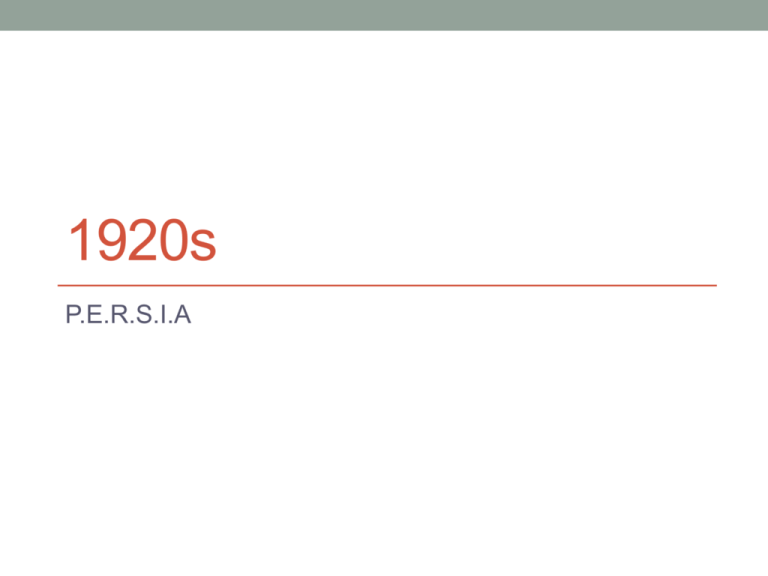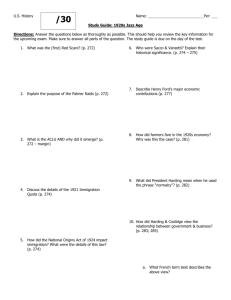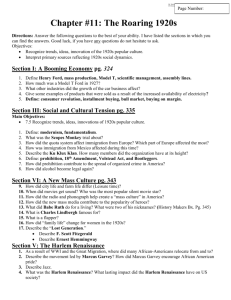1920s
advertisement

1920s P.E.R.S.I.A What can we infer about the 1920s by looking at this picture? Essential Question • To what extent do the 1920s illustrate the growing dichotomy of American society? PERSIA • Political • Economic • Religious • Social • Intellectual • Aesthetic Political • Who is president? Why? • Size of government • Role of government • Women in Politics Economic • Laissez-faire policy returns • Tariff • Innovation • Rising Middle Class • Stock Market Crash Religious/Social • Prohibition • Ku Klux Klan • Women’s roles • Immigration • Impact of Cars • Sports/Leisure Intellectual • Anti-German backlash • Anti-Socialist movement • Scopes Monkey Trial • Race Relations Aesthetic • Art • Music • Architecture • Literature • Harlem Renaissance • Movies Political • Election of 1916 v. 1920 • 1916 1920 • What do these results say about the policies and programs of Woodrow Wilson? • What could they say about the nature of the voting populace of the US? • “Return to normalcy” • What does Harding consider “normal”? Political (cont’d) • Warren G. Harding • Saw Presidency as largely symbolic • Delegated most affairs to others, and had little role in shaping any policy • Allowed tax cuts for the rich, stopped antitrust actions, and opposed organized labor • Regarded widely as one of the worst President’s in history Political (cont’d) • Calvin Coolidge (“Silent Cal”) – took over after Harding died • Philosophically, believed Providence had its own plan, which • • • • translated to very passive leadership Motto was “let well enough alone” Against League of Nations, foreign entanglement Still participated in L.A. economic imperialism One term president Political (cont’d) • Herbert Hoover • Secretary of Commerce under Harding and Coolidge • Rejected farm subsidies, supported prohibition, pledged lower taxes, and promised more of the same prosperity • "We in America today are nearer to the final triumph over poverty than ever before in the history of any land. The poorhouse is vanishing from among us." • President when Depression begins Politics in Perspective • Taking into account all the Presidents from the Gilded Age through the 1920s, what can we say about the American public’s view of the role/importance of the Office of President? • Be sure to compare and contrast the Progressive Presidents with Gilded Age/1920s Presidents. • Prior to the Great Depression, where does America stand on the issue of the importance of the President? Economic • Return to laissez-faire economics • No oversight meant speculation and shady deals were rampant • Policies were all intended to help the rich/business • Anti-labor / Pro-business • Protective tariff • Meant to raise prices on imported goods, therefore make higher priced American goods more competitive (good for American business) • Buying on credit introduced Religious/Intellectual • Prohibition • Women’s Christian Temperance Movement • Alcohol causes immoral behavior • Resurgence of the Ku Klux Klan • White Protestant group against Catholics, Jews, African Americans • Utilize extreme violence to achieve racial segregation and white supremacy • Felt threatened by blacks returning home from war and expecting more equal treatment for fighting in the war • Religious backlash • Fundamentalist movement • Religious reaction to innovation (automobile, flappers, etc) Religious/Intellectual • Scopes Monkey Trial • Tennessee vs. John Scopes • Violated state law prohibiting teaching of evolution • Battle between Progressive thought/Science and traditional religion Religious/Intellectual • Sacco and Vanzetti • Two Italian immigrant anarchists rounded up during the Red Scare • Convicted of robbery and murder despite a weak case • Received death penalty • Case illustrates the power of fear in America of radical immigrants Social • Women • Flappers • More women working since the war • Women wield political and economic power as they gain the right to vote and make purchasing decisions • In response to reports indicating that fully 80 percent of American women do not receive adequate prenatal care, Harding signs the Sheppard-Towner Maternity and Infancy Act, granting matching federal funds to states for maternal and child care. • Targeted by advertisers in the home, given a greater role outside the home Social • Immigration Issues • Restrictions fueled by fear of Communism and anarchists • Restrictions fueled by racism (Asia, India especially) • Quotas in 1920s based upon census of 1890, favoring northern Europeans who lived in US in large numbers at that time • Anti-Semitism was also prevalent • Henry Ford Social • Race Relations • Many white citizens held views of African Americans as inferiors, especially in the South • Jim Crow Laws • Separate but Equal • Virginia's Racial Integrity Act of 1924 codified the "one-drop rule" as the standard racial classification for people of mixed ancestry. A person with even "one drop" of non-white ancestry was classified as "colored" or non-white. • KKK and other white supremacists lynched, attacked, and terrorized blacks throughout the country • Tulsa Race Riot • Great Migration – movement of blacks from the South to Northern cities Aesthetic • “The Harlem Renaissance, also known as the New Negro Movement, was a literary, artistic, cultural, intellectual movement that began in Harlem, New York after World War I and ended around 1935 during the Great Depression. The movement raised significant issues affecting the lives of African Americans through various forms of literature, art, music, drama, painting, sculpture, movies, and protests. Voices of protest and ideological promotion of civil rights for African Americans inspired and created institutions and leaders who served as mentors to aspiring writers. Although the center of the Harlem Renaissance began in Harlem, New York, its influence spread throughout the nation and beyond and included philosophers, artists, writers, musicians, sculptors, movie makers and institutions that “attempted to assert…a dissociation of sensibility from that enforced by the American culture and its institutions.” • http://www.jcu.edu/harlem/index.htm Harlem Renaissance • The notion of "twoness" , a divided awareness of one's identity, was introduced by W.E.B. Du Bois, one of the founders of the NAACP: "One ever feels his two-ness - an American, a Negro; two souls, two thoughts, two unreconciled stirrings: two warring ideals in one dark body, whose dogged strength alone keeps it from being torn asunder." • It included racial consciousness, "the back to Africa" movement led by Marcus Garvey, racial integration, the explosion of music particularly jazz, spirituals and blues, painting, dramatic revues, and others.







